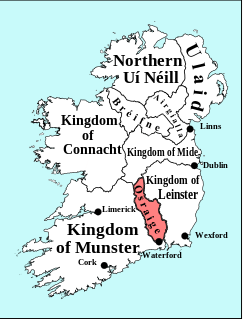Richard Deane was Bishop of Ossory [1] from 1610 [2] until his death in 1613. [3]
Deane was educated at Merton College, Oxford [4] and held the office of Dean of Ossory from 1603 until 1610. [5] He died on 20 February 1613. [6]
Richard Deane was Bishop of Ossory [1] from 1610 [2] until his death in 1613. [3]
Deane was educated at Merton College, Oxford [4] and held the office of Dean of Ossory from 1603 until 1610. [5] He died on 20 February 1613. [6]
| Church of Ireland titles | ||
|---|---|---|
| Preceded by John Horsfall | Bishop of Ossory 1586–1609 | Succeeded by Jonas Wheeler |
| | This article about an Irish Anglican bishop is a stub. You can help Wikipedia by expanding it. |

Vice-Admiral Thomas Butler, 6th Earl of Ossory, KG, PC, PC (Ire) (1634–1680) was an Irish soldier and politician. He was born at Kilkenny Castle, the eldest son of James Butler, 1st Duke of Ormond, and his wife Elizabeth Preston.

The kings of Osraige reigned over the medieval Irish kingdom of Osraige from the first or second century AD until the late twelfth century. Osraige was a semi-provincial kingdom in south-east Ireland which disappeared following the Norman Invasion of Ireland. A number of important royal Ossorian genealogies are preserved, particularly MS Rawlinson B502, which traces the medieval Mac Giolla Phádraig dynasty back through Óengus Osrithe, who supposedly flourished in the first or second century. and one in the Book of Leinster. Recent analysis of ninth and tenth century regnal succession in Osraige has suggested that in peaceful times, kingship passed primarily from eldest to youngest brother, before crossing generations and passing to sons and nephews.
The Bishop of Waterford and Lismore is an episcopal title which takes its name after the city of Waterford and town of Lismore in Ireland. The title was used by the Church of Ireland until 1838, and is still used by the Roman Catholic Church.

The Archbishop of Dublin is an archiepiscopal title which takes its name after Dublin, Ireland. Since the Reformation, there have been parallel apostolic successions to the title: one in the Catholic Church and the other in the Church of Ireland. The archbishop of each denomination also holds the title of Primate of Ireland.

The history of Kilkenny began with an early sixth-century ecclesiastical foundation, this relates to a church built in honour of St. Canice, now St. Canice's Cathedral and was a major monastic centre from at least the eighth century. The Annals of the Four Masters recorded the first reference Cill Chainnigh in 1085. Prehistoric activity has been recorded suggesting intermittent settlement activity in the area in the Mesolithic and Bronze Age. Information on the history of Kilkenny can be found from newspapers, photographs, letters, drawings, manuscripts and archaeology. Kilkenny is documented in manuscripts from the 13th century onwards and one of the most important of these is Liber Primus Kilkenniensis.
The Rt Rev Robert Fowler, DD, MA was an eminent Anglican bishop in the late eighteenth and early 19th centuries.

Upper Ossory was an administrative barony in the south and west of Queen's County in Ireland. In late Gaelic Ireland it was the túath of the Mac Giolla Phádraig (Fitzpatrick) family and surviving remnant of the once larger kingdom of Ossory. The northernmost part of the Diocese of Ossory and medieval County Kilkenny, it was transferred to the newly created Queen's County in 1600. In the 1840s its three component cantreds, Clarmallagh, Clandonagh, and Upperwoods, were promoted to barony status, thereby superseding Upper Ossory.

The Dean of Cashel is the head of the Chapter of the Cathedral Church of St John the Baptist and St Patrick's Rock, Cashel, one of the Church of Ireland cathedrals of the united Diocese of Cashel, Ferns and Ossory.
The Dean of Kilkenny or Dean of Ossory is based at The Cathedral Church of St Canice, Kilkenny in the united Diocese of Cashel and Ossory within the Church of Ireland.
Sir John Hotham, 9th Baronet, DD (1734–1795) was an English baronet and Anglican clergyman. He served in the Church of Ireland as the Bishop of Ossory from 1779 to 1782 and Bishop of Clogher from 1782 to 1795.
Randolph Barlow, was made Pembroke College fellow at Cambridge University in 1593; attained Master of Arts in 1594; awarded Doctor of Divinity in 1600; took holy orders and later served in the Church of Ireland as the Archbishop of Tuam from 1629 to 1638.
The Rt Rev. Thomas Otway, DD was a Seventeenth century Anglican bishop in Ireland.

The Archdeacon of Ossory was a senior ecclesiastical officer within the Diocese of Ossory until 1835 and then within the Bishop of Ossory, Ferns and Leighlin until 1977 when it was further enlarged to become the Diocese of Cashel and Ossory. As such he was responsible for the disciplinary supervision of the clergy within the Cloyne Diocese.
Henry Hall was an English Anglican priest in Ireland in the seventeenth century.

The Archdeacon of Leighlin was a senior ecclesiastical officer within the Diocese of Ferns and Leighlin until 1835 and then within the Diocese of Ossory, Ferns and Leighlin until 1977 when it was further enlarged to become the Diocese of Cashel and Ossory. As such he was responsible for the disciplinary supervision of the clergy within the Cloyne Diocese.
John Horsfall, a Yorkshireman, was Bishop of Ossory from 1586 until his death in 1609.
Jonas Wheeler (1543–1640) was Bishop of Ossory from 1613 until his death in 1640.
Charles Knox was Archdeacon of Armagh from 1814 until his death.
Gilbert Deane was an Anglican priest in Ireland during the second half of the seventeenth century.
Joseph Bourke was an Anglican priest in Ireland during the late 18th and early 19th Centuries.